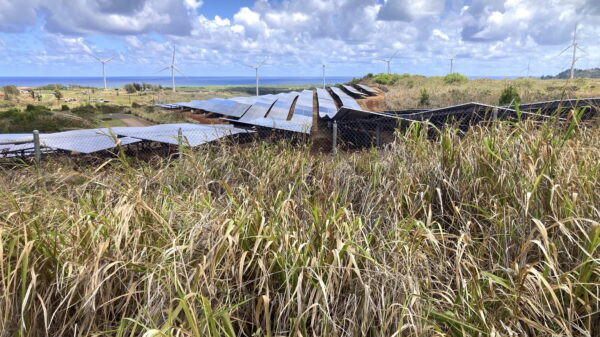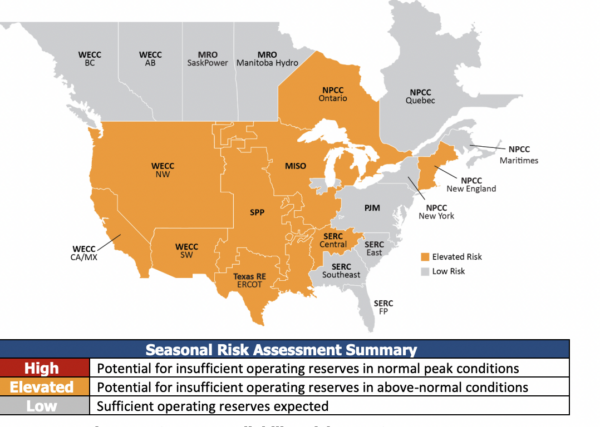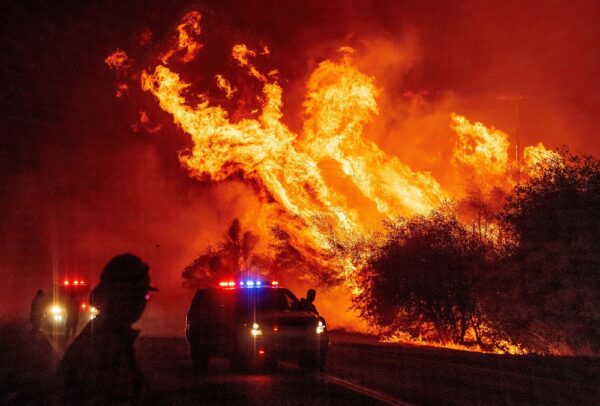
More than two-thirds of North America could see electrical outages when temperatures spike this coming summer because utilities in many areas do not have sufficient reserve generation capacity to meet surges in demand.
According to an annual summer reliability assessment published on May 17 by the North American Electric Reliability Corporation (NERC), the power grid in at least eight regions of the United States and one in Ontario, Canada, face elevated risk of brown-outs and black-outs during heat waves between June and September, attributed at least partially to the disruption being caused by the growing reliance on so-called “green” energies that advocates want to see supplant fossil fuels.


“The elevated risk profiles that we’re seeing are driven by a combination of conventional generation retirements seen over the last couple of years, a substantial increase in forecasted peak demand and new loads coming—we are electrifying more than we ever had in the past,” NERC Director of Reliability John Moura told reporters during a conference call following the release of the assessment.
NERC is a not-for-profit public-private entity that provides the U.S. Department of Energy (DOE) and state regulators with reliability assessments of the electrical grid from Canada to northern Mexico.
The report (pdf) cites the “rapidly-changing resource mix” driven by President Joe Biden’s goal to “decarbonize” the U.S. electrical grid by 2035 as spurring a disjointed transition from oil, gas, and natural gas to renewable energies, such as wind, solar, and nuclear, before the grid can adjust and expand transmission capacities.
“The drivers here are demand growth and generation retirements that take away from dispatchable generation that is needed to maintain reliability over a range of conditions,” NERC Reliability Assessments Manager Mark Olson said.
National Association of Regulatory Utility Commissioners (NARUC) Executive Director Greg R. White told The Epoch Times that while he had not done a deep dive on NERC’s assessment as yet, its warning of summer power outages contains “no surprises.”
“The pace in which we are closing fossil fuel plants is exceeding the pace that we are bringing new plants online,” White said. “If you are paying attention to what is going on in this industry, the industry has been saying the transition [from fossil fuels to renewables] would be challenging.”
Senior Regulatory Counsel for the American Public Power Association (APPA) John McCaffrey concurred.
“NERC’s conclusions reinforce APPA’s concerns about the reliability ramifications associated with the pace of the resource transition in the United States,” he told The Epoch Times by email.
“APPA also shares NERC’s concerns about the potential adverse reliability impacts of the current critical shortage of distribution transformers, and we agree with NERC that new distribution transformer efficiency standards recently proposed by the U.S. Department of Energy could worsen the transformer supply shortage.”
The NERC report maintains that constraints on natural gas and coal delivery infrastructure, new federal environmental restrictions, supply chain issues, declining water levels near some hydropower plants, and “unexpected tripping” of wind and solar resources all contribute to the uncertainty.
The assessment states that new environmental rules that restrict power plant emissions will limit the operation of coal-fired generators in 23 states.
Those new rules include most notably the Environmental Protection Agency’s (EPA) “Good Neighbor Plan,” finalized in March, to ensure the 23 states meet the Clean Air Act’s “Good Neighbor” smog requirements “by reducing pollution that significantly contributes to problems attaining and maintaining the EPA’s health-based air quality standard for ground- level ozone in downwind states.”
The most likely way the coal- and natural gas-fired plants will meet those clean air standards is “by limiting hours of operation in this first year of implementation rather than through adding emissions control equipment.”
“As this assessment underscores, EPA’s regulatory blitz is already threatening the reliable delivery of power and undermining efforts to tame energy-driven inflation,” National Mining Association (NMA) president and CEO Rich Nolan said.
“The nation is firmly in a grid reliability crisis that will only grow more acute if [the] EPA continues to drive an agenda that forces the closure of the essential generating capacity that underpins grid reliability before reliable alternatives, and their supporting infrastructure, are in place,” Nolan said in a statement. “With rising electricity demand a new reality—driven by electrification—we should be building on the shoulders of our existing coal fleet, not imposing a suite of mandates to tear it down.”


The regional grids most at risk are: the Midcontinent Independent System Operator (MISO), which manages grids in 15 states and the Canadian province of Manitoba; Northeast Power Coordinating Council (NPCC) New England, which includes utilities in seven states and the Canadian provinces of Ontario, Québec, New Brunswick, and Nova Scotia; SERC-Central, which spans 16 southeastern and south-central states; Southwest Power Pool (SPP), which includes utilities and transmission companies in 17 states; Electric Reliability Council of Texas (ERCOT), which supplies power to more than 25 million Texans and represents 90 percent of the state’s electric load; The Western Interconnection, which serves more than 80 million customers across all or part of 14 states, Canadian provinces of British Columbia and Alberta, and the northern reaches of Baja California in Mexico; and NPPC-Ontario.
According to NERC, all of the regional grids are expected to meet demands during normal operations.
In the MISO grid, the assessment states that “the risk of being unable to meet reserve requirements at peak demand this summer … is lower now than in 2022” and that it should “have sufficient resources … for normal summer peak demand.”
But the question here as well as in other regional grids, NERC maintains, is “wind generator performance during periods of high demand.”
Since NERC says in its assessment that the MISO grid will rely on wind to meet surges in demand, as a result, “MISO can face challenges in meeting above-normal peak demand if wind generator energy output is lower than expected.”
In NPCC-New England’s grid, emergency resources and supplies “from neighboring areas are likely to be needed during more extreme demand or low resource conditions” and in NPCC-Ontario, a planned offline refurbishment of a nuclear power plant and a “constrained transmission network” could cause power outages, with the Windsor-Essex area being particularly vulnerable, NERC said.
SERC-Central can sustain normal demand. But while its grid generation capacity has remained flat, “forecasted peak demand has risen by over 950 megawatts (MW).” Meanwhile, in the SPP grid, reserve margins have dipped in response to “declining anticipated resources.”
“Like MISO,” NERC said, “the energy output of SPP’s wind generators during periods of high demand is a key factor in determining whether there is sufficient electricity supply on the system. SPP can face energy challenges in meeting extreme peak demand or managing periods of thermal or hydro generator outages if wind resource energy output is below normal.”
In ERCOT’s grid, NERC documented “strong growth in both resources and forecasted demand,” meaning that supply to the grid is adequate for normal operations but, with the infusion of green energies in the mix, has not been tested in a peak demand surge.
Since 2022, ERCOT has added more than 4 gigawatts (GW) of new solar generation capacity. NERC said that “load reductions from dispatchable demand response programs have grown by over 18 percent to total 3,380 MWs.”
With economic development on ERCOT’s grid driving a 6 percent increase in demand, “dispatchable generation may not be sufficient to meet reserves during an extreme heat-wave that is accompanied by low winds,” the assessment states.
In the Western Interconnection grid, “wide-area heat events” risk creating energy supply shortfalls because “each area [in the sprawling grid] relies on regional transfers to meet demand at peak and the late afternoon to evening hours when energy output from the area’s vast solar PV resources are diminished.”


Wildfire is also a risk the region’s transmission network, NERC said, noting that fires “often accompany these wide-area heat events, can limit electricity transfers, and result in localized load shedding.”
NARUC’s White noted that while NERC has identified nine “elevated risk” areas, this year’s pre-summer assessment has not designated any grids as being at “high risk” of going dark.
“If there was any surprise, it is that [the assessment] is not worse than it was,” he said. “I guess I would have expected to see at least a few ‘high risk’ areas. Maybe that means we are doing better than we thought.”
The summers are getting hotter, White said, with heat waves causing power demand surges in areas where such events were rare.
Sustained heat waves can “change the dynamics of the grid,” he said. “The grid operates on [a] highly sensitive level of balancing. It doesn’t take much to lose that balance. We are always at risk of something happening in the system.”
White said that utilities and transmission companies are finding it difficult “to keep up with the transition” and that financial pressures from a surge of investment into renewables is creating “some opportunities for arbitrage through using transmission” to battery storage at times of higher renewable supply for use during peak demand.
NERC’s assessment confirms what Federal Energy Regulatory Commission (FERC) Commissioner Mark Christie told the Senate Energy & Natural Resources Committee in a May 4 hearing.
“The United States is heading for a reliability crisis,” he said. “I do not use the term ‘crisis’ for melodrama but because it is an accurate description of what we are facing,” Christie said. “I think anyone would regard an increasing threat of system-wide, extensive power outages as a crisis.”
Committee chair Sen. Joe Manchin (D-W.V.) and ranking Republican Sen. John Barrasso (R-Wyo.) have warned that “premature fossil retirements” amid increasing demand for power are the result of Biden’s green energy initiatives passed in 2021’s Bipartisan Infrastructure Law (BIL) and 2022’s Inflation Reduction Act (IRA), which incentivized investments in renewable energy.
The incentives have proven effective in inducing investor interest—maybe too successfully, with projects being proposed and approved sooner than expected and faster than the grid’s transmission capacity is expanding.
There were approximately 10,000 energy projects in April designed to produce more than 2,000 GW of collective power—although not reliably—waiting for permits from federal and state agencies to connect to electric grids across the United States.
That is roughly twice the collective electricity output of the 1,250 GW now being produced by all the nation’s power plants—most of which were built to reliably generate power on demand using fossil fuels.
The dual bottleneck of the grid’s limited transmission infrastructure and fossil fuel plants being retired at a rate faster than new plants using unreliable renewable energy sources are being built to replace them will have a lot of people paying attention to weather forecasts this summer, NMA’s Nolan said.
“This assessment is another clear warning that large swaths of the country face the very real threat of blackouts should the weather not cooperate this summer,” he said.
“The nation is increasingly short of the dispatchable capacity it needs to maintain resource adequacy during periods of peak demand. Hoping that the weather cooperates to avoid catastrophic consequences for American families can’t be an acceptable status quo.”
Subscribe to George Magazine and unlock exclusive bonuses. Your subscription now includes a free crypto essentials guide and three premium downloadable images. These images are perfect for personal use as desktop or mobile backgrounds, with thumbnail previews shown below.




Discount Applied Successfully!
Your savings have been added to the cart.